NCERT Solutions For Class 10 Maths Chapter 7 Coordinate Geometry
NCERT Solutions For Class 10 Maths Chapter 7 Coordinate Geometry Ex 7.1
Ex 7.1 Class 10 Maths Question 1.
Find the distance between the following pairs of points:
(i) (2, 3), (4, 1)
(ii) (-5, 7), (-1, 3)
(iii) (a, b), (-a, -b)
Solution:
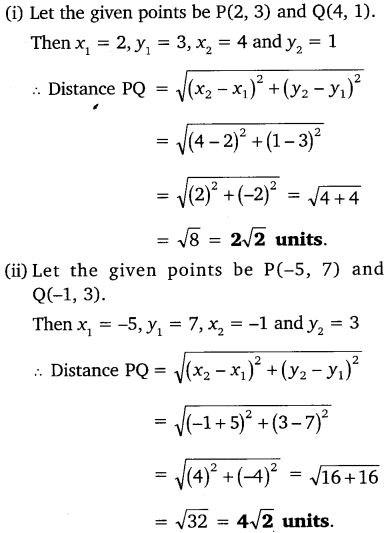
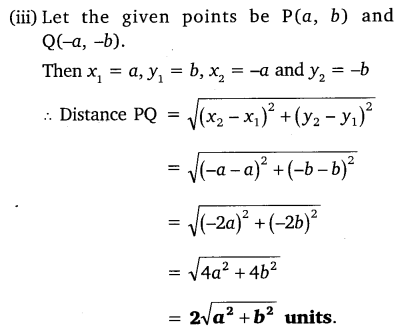
Ex 7.1 Class 10 Maths Question 2.
Find the distance between the points (0, 0) and (36, 15).
Solution:

You can also download the free PDF of Chapter 7 Ex 7.1 Coordinate Geometry NCERT Solutions or save the solution images and take the print out to keep it handy for your exam preparation.
Ex 7.1 Class 10 Maths Question 3.
Determine if the points (1, 5), (2, 3) and (-2, -11) are collinear.
Solution:
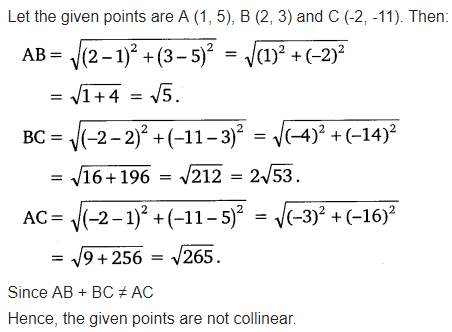
Ex 7.1 Class 10 Maths Question 4.
Check whether (5, -2), (6, 4) and (7, -2) are the vertices of an isosceles triangle.
Solution:
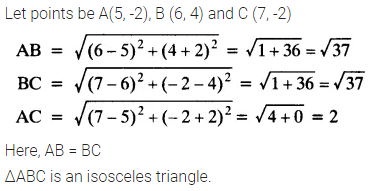
Ex 7.1 Class 10 Maths Question 5.
In a classroom, 4 friends are seated at the points A, B, C and D as shown in the given figure. Champa and Chameli walk into the class and after observing for a few minutes Champa asks Chameli, “Don’t you think ABCD is a square?” Chameli disagrees. Using distance formula, find which of them is correct.
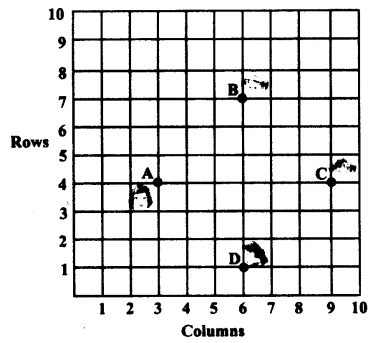
Solution:
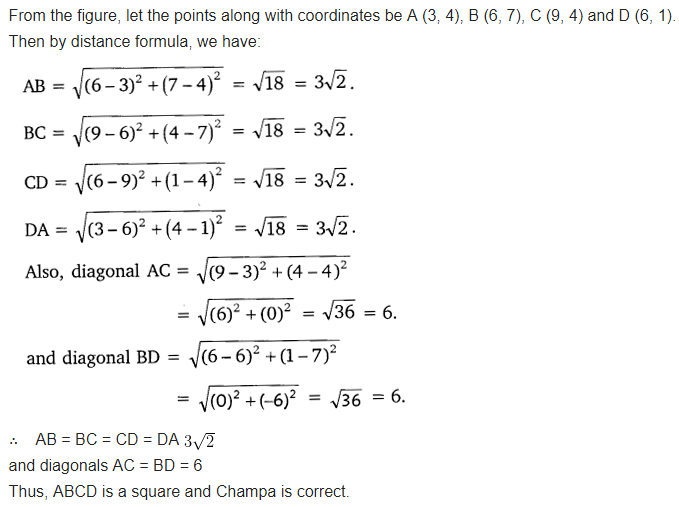
Ex 7.1 Class 10 Maths Question 6.
Name the type of quadrilateral formed, if any, by the following points, and give reasons for your answer.
(i) (-1, -2), (1, 0), (-1, 2), (-3, 0)
(ii) (-3, 5), (3, 1), (0, 3), (-1, -4)
(iii) (4, 5), (7, 6), (4, 3), (1, 2)
Solution:
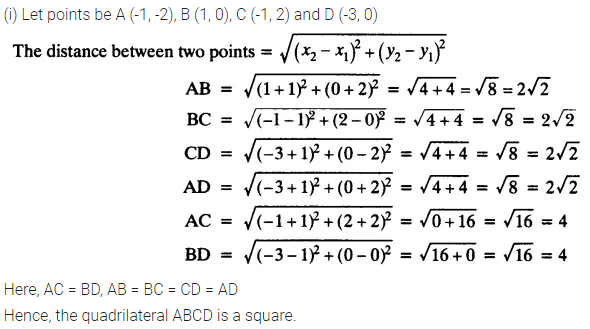
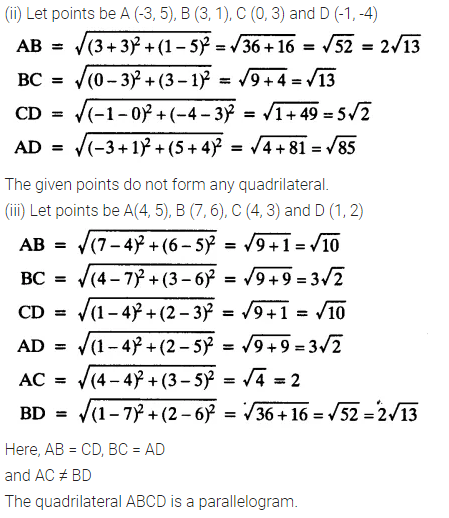
Ex 7.1 Class 10 Maths Question 7.
Find the point on the x-axis which is equidistant from (2, -5) and (-2, 9).
Solution:
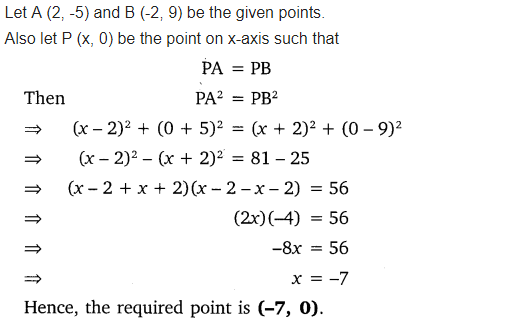
Ex 7.1 Class 10 Maths Question 8.
Find the values of y for which the distance between the points P (2, -3) and Q (10, y) is 10 units.
Solution:
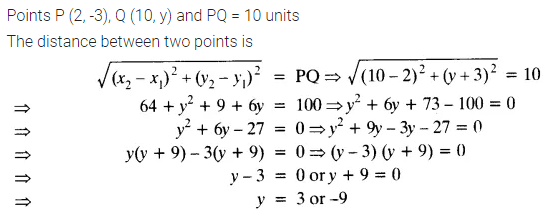
Ex 7.1 Class 10 Maths Question 9.
If Q (0, 1) is equidistant from P (5, -3), and R (x, 6), find the values of x. Also, find the distances QR and PR.
Solution:
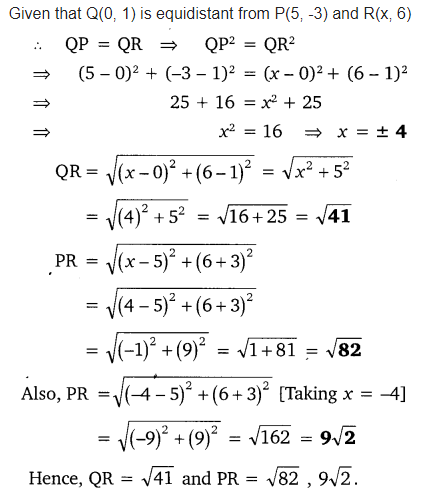
Ex 7.1 Class 10 Maths Question 10.
Find a relation between x and y such that the point (x, y) is equidistant from the points (3, 6) and (-3, 4).
Solution:
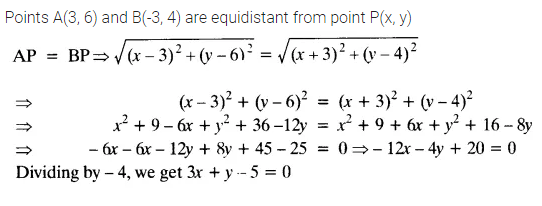
Class 10 Maths Coordinate Geometry Mind Maths
Coordinate of a Point in XY – Plane
The Perpendicular distance of x a point from the y-axis is called its x-coordinate or abscissa. The perpendicular distance y of a point from the x-axis is called its y-coordinate or ordinate. The x and y taken together in order is called coordinte of point denoted by (x, y).
The coordinate of the points on x-axis are of the form (x, 0) and the points on the y-axis are of the form(0, y). Coordinate of origin is (0, 0).
Sign-conventions in the XY-Plane
The x and y-axis divide the plane into four parts known as quadrants denoted by I, II, III and IV. The sign of x and y-coordinates in each of the quadrant is shown below:
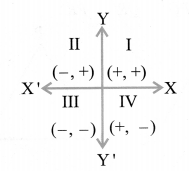
Distance Formula
The distance between any two points
P(x1, y1) and Q(x2, y2) in the plane is given by,
![]()
Also the distance of the point P(x1, y1) from the origin is
![]()
Section Formula

The coordinates of the point P(x, y) which divides the line segment joining the points A(x1, y1) and B(x2, y2) internally in the ratio m1 : m2 i.e., PA/PB=m1/m2

The coordinates of the point P(x, y) which divides the line segment joining the points A(x1, y1) and B(x2, y2) externally in the ratio, m1 : m2 i.e., PA/PB=m1/m2 are

(iii) If the ratio in which P divides AB is K : 1, then the coordinates of the point P will be

Mid-Point Formula
The coordinates of the mid point P of the line segment joining the points A(x1, y1) and B(x2, y2) is

Area of a Triangle
The area of ∆ABC formed by the vertices A(x1, y1), B(x2, y2) is given by
![]()
Note:
(i) Area of triangle = 1/2 × base × Altitude
(ii) Area of polygon can be calculated by dividing it into the triangular region.
(iii) If three points are collinear then area of the triangle formed by them is zero.
NCERT Solutions For Class 10 Maths Chapter 7 Coordinate Geometry Ex 7.2
NCERT Solutions for Class 10 Maths Chapter 7 Coordinate Geometry Ex 7.2 are part of NCERT Solutions for Class 10 Maths. Here we have given NCERT Solutions for Class 10 Maths Chapter 7 Coordinate Geometry Ex 7.2.
Ex 7.2 Class 10 Maths Question 1.
Find the coordinates of the point which divides the join of (-1, 7) and (4, -3) in the ratio 2 : 3.
Solution:
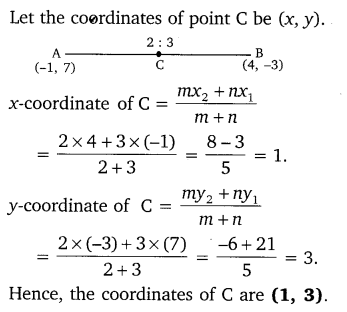
Ex 7.2 Class 10 Maths Question 2.
Find the coordinates of the points of trisection of the line segment joining (4, -1) and (-2, -3).
Solution:
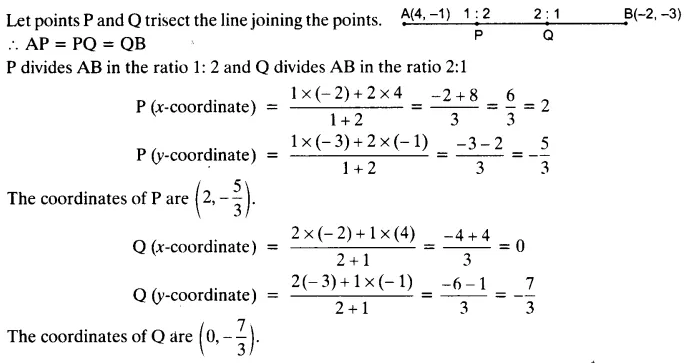
Ex 7.2 Class 10 Maths Question 3.
To conduct Sports Day activities, in your rectangular shaped school ground ABCD, lines have been drawn with chalk powder at a distance of 1 m each. 100 flower pots have been placed at a distance of 1 m from each other along AD, as shown in given
figure below. Niharika runs 1/4 th the distance AD on the 2nd line and posts a green flag. Preet runs 1/5 th distance AD on the eighth line and posts a red flag. What is the distance between both the flags? If Rashmi has to post a blue flag exactly halfway between the line segment joining the two flags, where should she post her flag?
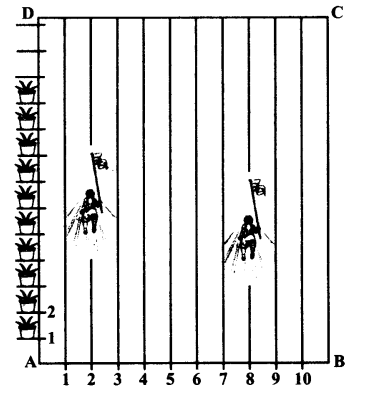
Solution:
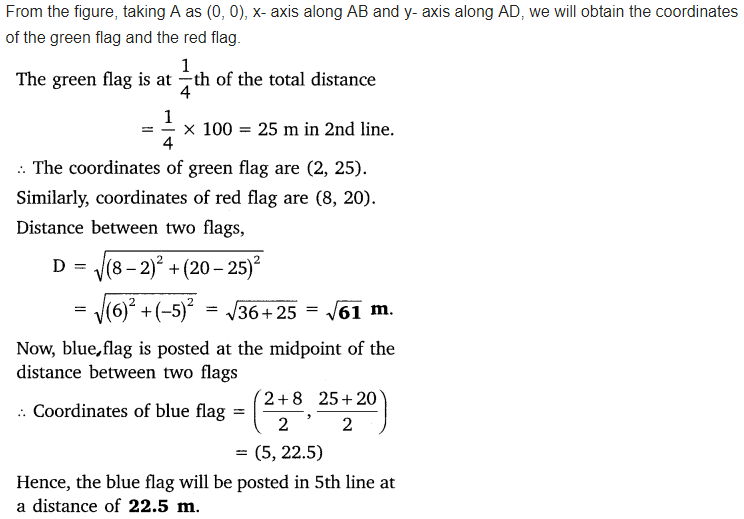
The blue flag is in the 5th line, at a distance of 22.5 m.
Ex 7.2 Class 10 Maths Question 4.
Find the ratio in which the line segment joining the points (-3, 10) and (6, -8) is divided by (-1, 6).
Solution:
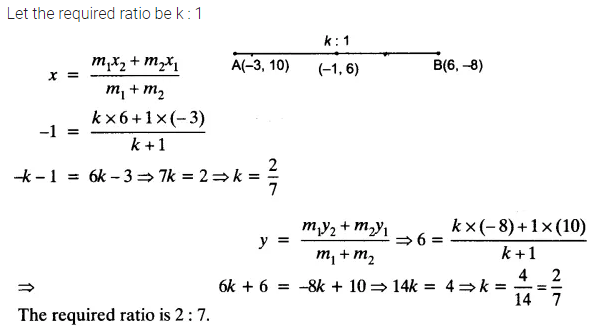
Ex 7.2 Class 10 Maths Question 5.
Find the ratio in which line segment joining A (1, -5) and B (-4, 5) is divided by the x-axis. Also, find the coordinates of the point of division.
Solution:
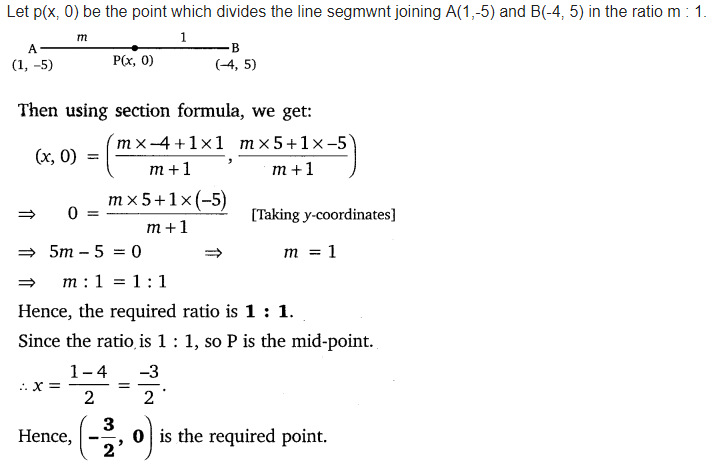
Ex 7.2 Class 10 Maths Question 6.
If (1, 2), (4, y), (x, 6) and (3, 5) are the vertices of a parallelogram taken in order, find x and y.
Solution:

Ex 7.2 Class 10 Maths Question 7.
Find the coordinates of a point A, where AB is the diameter of a circle whose centre is (2, -3) and B is (1, 4).
Solution:
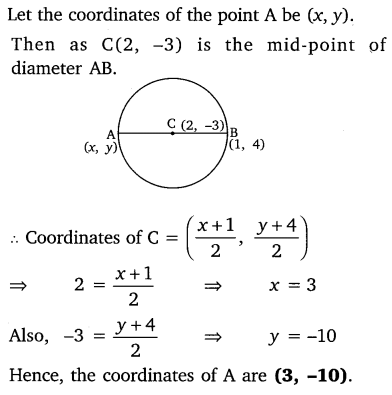
Ex 7.2 Class 10 Maths Question 8.
If A and B are (-2, -2) and (2, -4), respectively, find the coordinates of P such that AP = 3/7 AB and P lies on the line segment AB.
Solution:
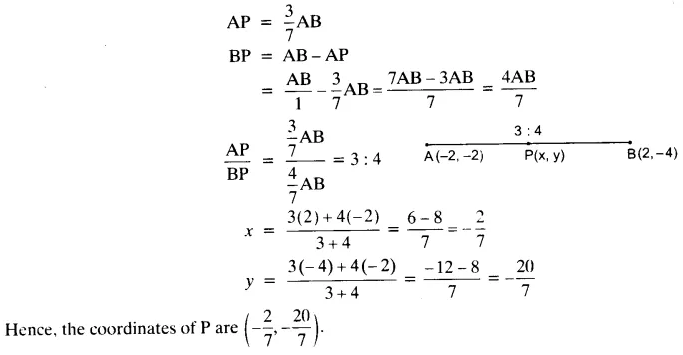
Ex 7.2 Class 10 Maths Question 9.
Find the coordinates of the points which divide the line segment joining A (-2, 2) and B (2, 8) into four equal parts.
Solution:
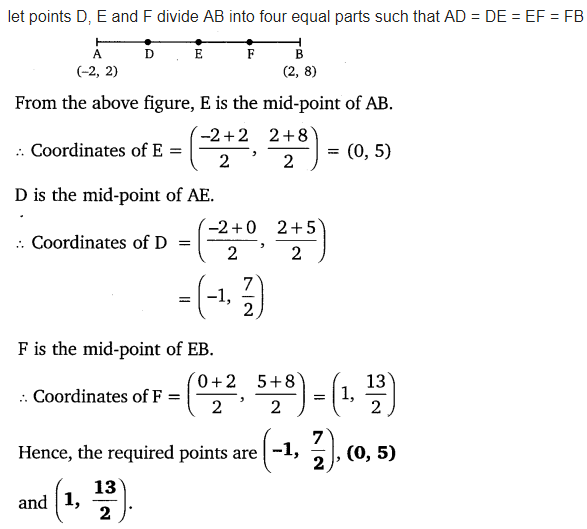
Ex 7.2 Class 10 Maths Question 10.
Find the area of a rhombus if its vertices are (3, 0), (4, 5), (-1, 4) and (-2, -1) taken in order.
[Hint: Area of a rhombus = 1/2 (product of its diagonals)]
Solution:
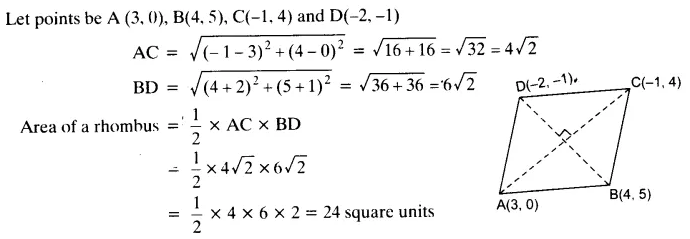
NCERT Solutions For Class 10 Maths Chapter 7 Coordinate Geometry Ex 7.3
NCERT Solutions for Class 10 Maths Chapter 7 Coordinate Geometry Ex 7.3 are part of NCERT Solutions for Class 10 Maths. Here we have given NCERT Solutions for Class 10 Maths Chapter 7 Coordinate Geometry Ex 7.3.
Ex 7.3 Class 10 Maths Question 1.
Find the area of the triangle whose vertices are:
(i) (2, 3), (-1, 0), (2, -4)
(ii) (-5, -1), (3, -5), (5, 2)
Solution:
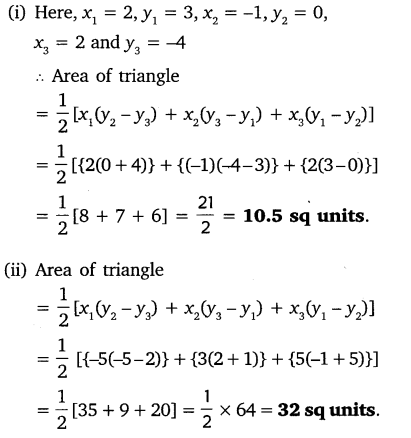
Ex 7.3 Class 10 Maths Question 2.
In each of the following find the value of ‘k’ for which the points are collinear.
(i) (7, -2), (5, 1), (3, k)
(ii) (8, 1), (k, -4), (2, -5)
Solution:
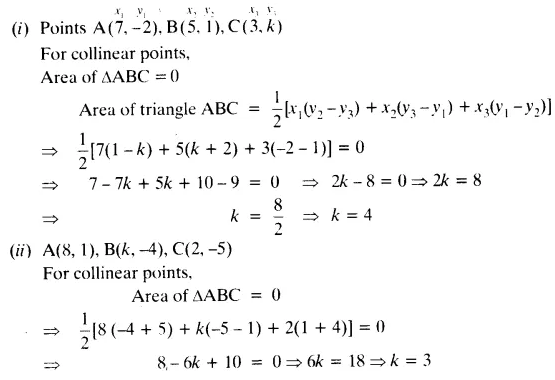
Ex 7.3 Class 10 Maths Question 3.
Find the area of the triangle formed by joining the mid-points of the sides of the triangle whose vertices are (0, -1), (2, 1) and (0, 3). Find the ratio of this area to the area of the given triangle.
Solution:
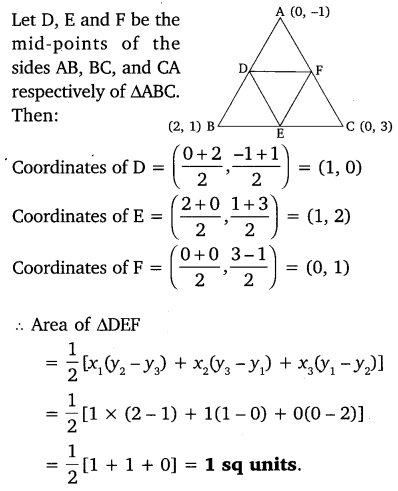
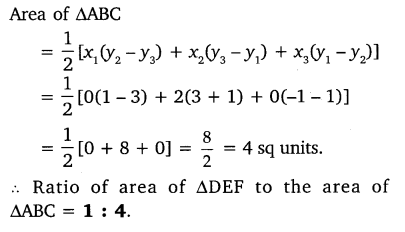
Ex 7.3 Class 10 Maths Question 4.
Find the area of the quadrilateral whose vertices, taken in order, are (-4, -2), (-3, -5), (3, -2) and (2, 3).
Solution:
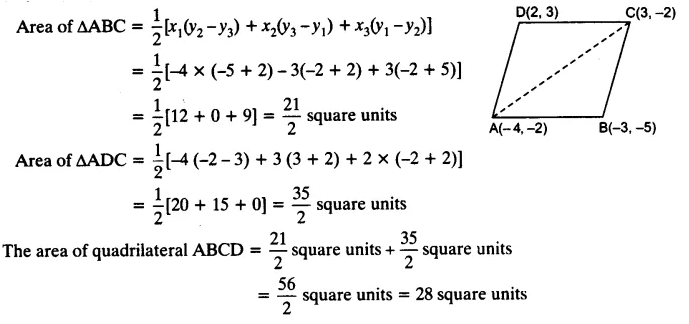
Ex 7.3 Class 10 Maths Question 5.
You have studied in Class IX, that a median of a triangle divides it into two triangles of equal areas. Verify this result for ∆ABC whose vertices are A (4, -6), B (3, -2) and C (5, 2).
Solution:
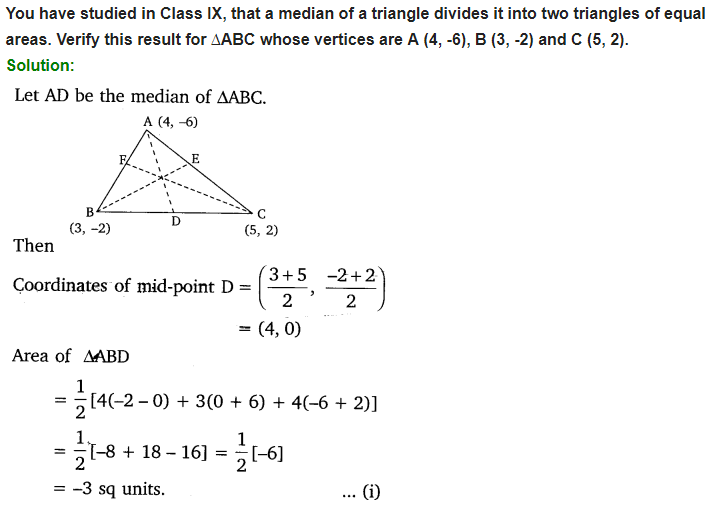
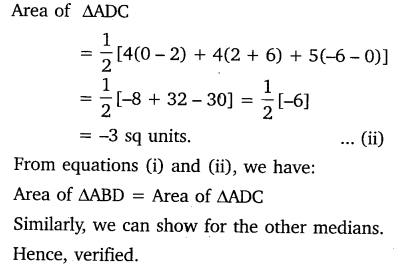
NCERT Solutions For Class 10 Maths Chapter 7 Coordinate Geometry Ex 7.4
NCERT Solutions for Class 10 Maths Chapter 7 Coordinate Geometry Ex 7.4 are part of NCERT Solutions for Class 10 Maths. Here we have given NCERT Solutions for Class 10 Maths Chapter 7 Coordinate Geometry Ex 7.4.
Ex 7.4 Class 10 Maths Question 1.
Determine the ratio, in which the line 2x + y – 4 = 0 divides the line segment joining the points A(2, -2) and B(3, 7).
Solution:
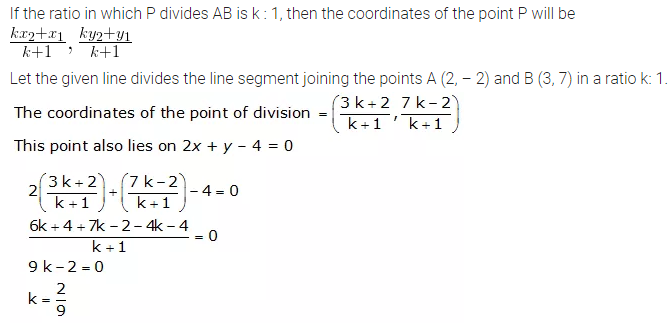
Ex 7.4 Class 10 Maths Question 2.
Find a relation between x and y, if the points (x, y), (1, 2) and (7, 0) are collinear.
Solution:
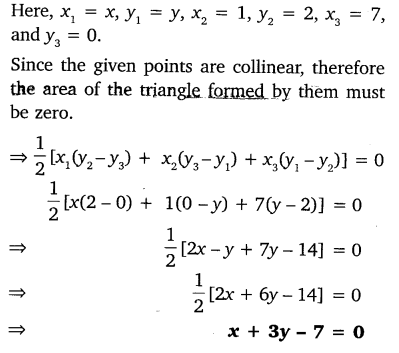
Ex 7.4 Class 10 Maths Question 3.
Find the centre of a circle passing through the points (6, -6), (3, -7) and (3, 3).
Solution:
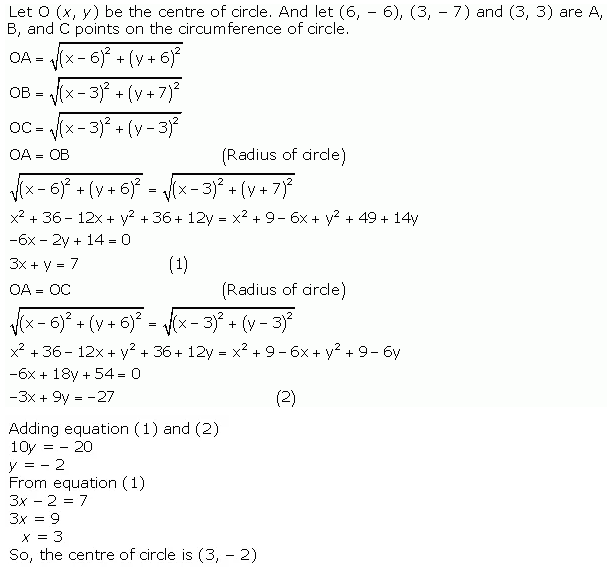
Ex 7.4 Class 10 Maths Question 4.
The two opposite vertices of a square are (-1, 2) and (3, 2). Find the coordinates of the other two vertices.
Solution:
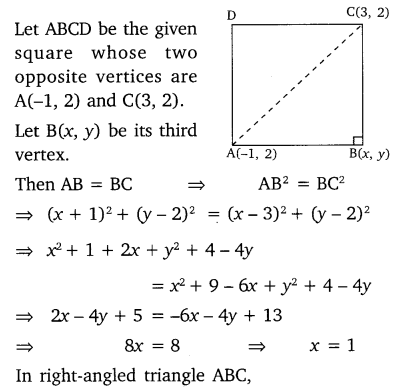
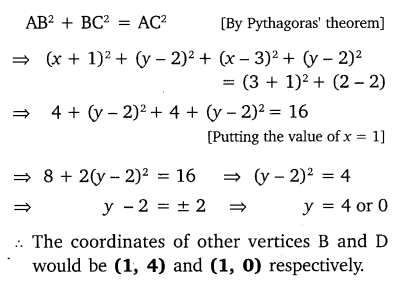
Ex 7.4 Class 10 Maths Question 5.
The class X students school in krishnagar have been allotted a rectangular plot of land for their gardening activity. Saplings of Gulmohar are planted on the boundary at a distance of 1 m from each other. There is triangular grassy lawn in the plot as shown in the figure. The students are to sow seeds of flowering plants on the remaining area of the plot.
(i) Taking A as origin, find the coordinates of the vertices of the triangle.
(ii) What will be the coordinates of the vertices of ∆PQR, if C is the origin?
Also, calculate the areas of the triangles in these cases. What do you observe?
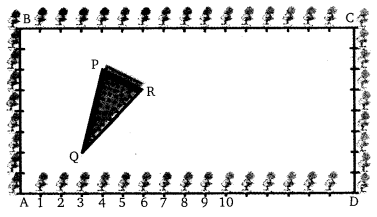
Solution:
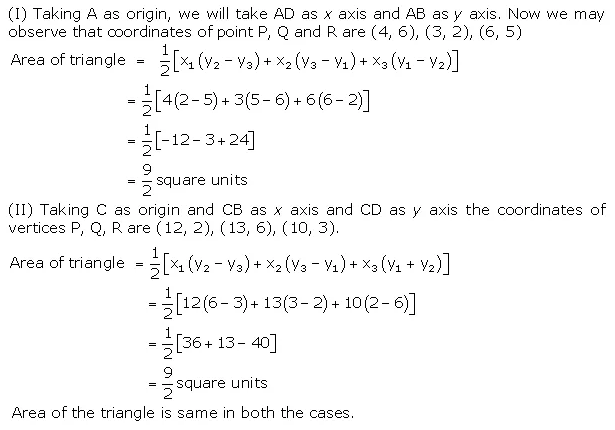
Ex 7.4 Class 10 Maths Question 6.
The vertices of a VABC are A(4, 6), B(1, 5) and C(7, 2). A line is drawn to intersect sides AB and AC at D and E respectively. such that AD/AB=AE/AC=1/4. calculate the area of the ∆ADe and compare it with the area of ∆ABC.
Solution:
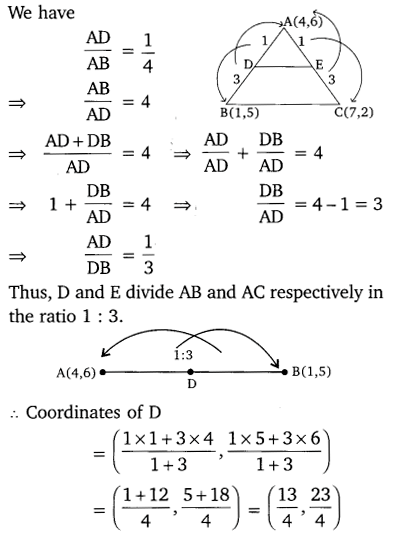
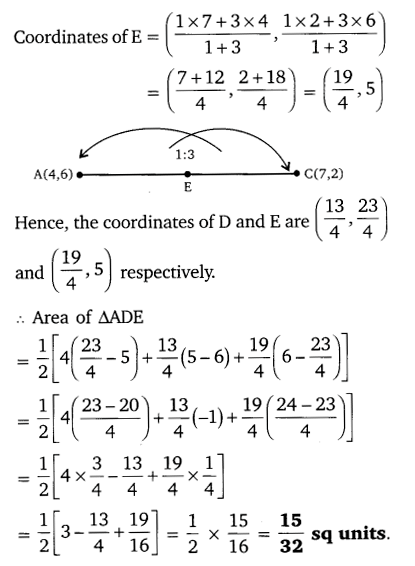
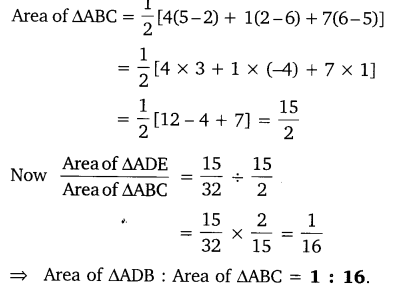
Ex 7.4 Class 10 Maths Question 7.
Let A(4, 2), B(6,5) and C(1, 4) be the vertices of ∆ABC.
(i) The median from A meters BC at D. Find the coordinates of the point D.
(ii) Find the coordinates of the point P on the AD, such that AP: PD = 2: 1.
(iii) Find the coordinates of points Q and R on medians BE and CF respectively, such that BQ: QE = 2: 1 and CR: RF = 2: 1.
(iv) What do you observe?
[Note: The points which are common to all the three medians is called centroid and this point divides each median in the ratio 2: 1]
(v) If A(x1, y1), B(x2, y2) and C(x3, y3) are the vertices of ∆ABC, find the coordinates of the centroid of the triangles.
Solution:
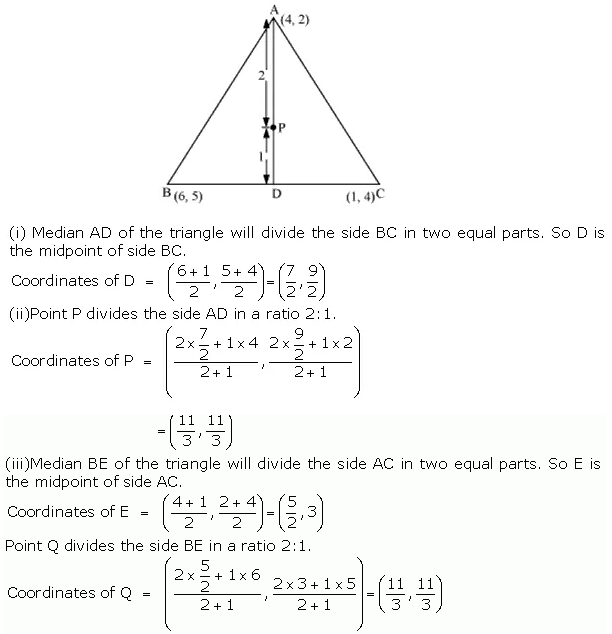
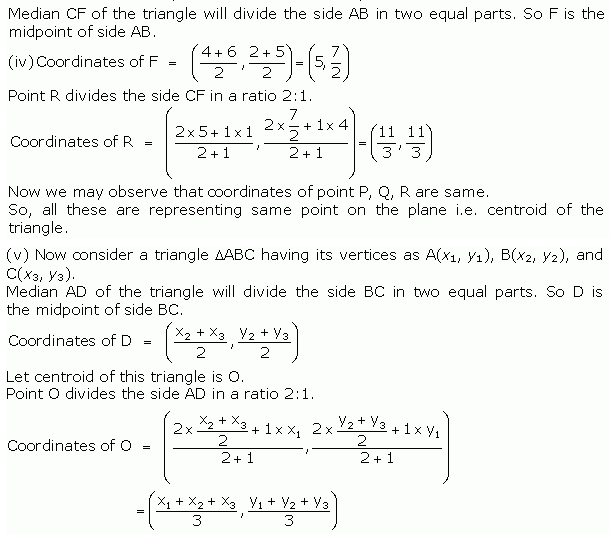

Ex 7.4 Class 10 Maths Question 8.
ABCD is a rectangle formed by the points A(-1, -1), B(-1, 4), C(5, 4) and D(5, -1), P, Q, R and S are the mid-points of Ab, BC, CD and DA respectively. Is the quadrilateral PQRS a square? a rectangle? or a rhombus? Justify your answer.
Solution:
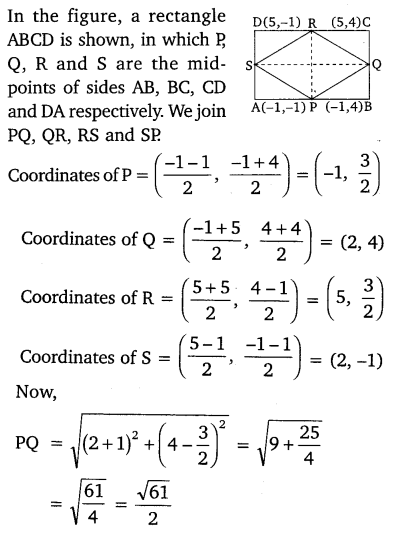
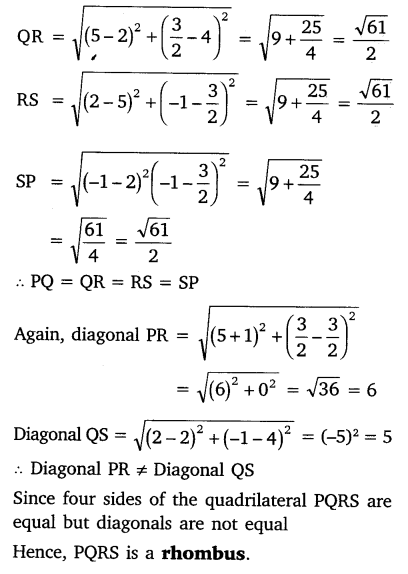
Coordinate Geometry Class 10 Extra Questions Maths Chapter 7
Extra Questions for Class 10 Maths Chapter 7 Coordinate Geometry. According to new CBSE Exam Pattern, MCQ Questions for Class 10 Maths Carries 20 Marks.

Important Questions for Class 10 Maths Chapter 7 Coordinate Geometry
Coordinate Geometry Class 10 Important Questions Very Short Answer (1 Mark)
Question 1.
Find the distance of the point (-3, 4) from the x-axis. (2012OD)
Solution:
B(-3, 0), A (-3, 4)
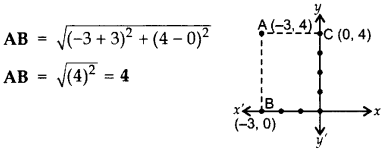
Question 2.
If the points A(x, 2), B(-3, 4) and C(7, -5) are collinear, then find the value of x. (2014D)
Solution:
When the points are collinear,
x1(y2 – y3) + x2(y3 – y1) + x3(y1 – y2) = 0
x(-4 – (-5)) + (-3)(-5 – 2) + 7(2 – (-4)) = 0
x(1) + 21 + 42 = 0
x + 63 = 0 ∴ x = -63
Question 3.
For what value of k will k + 9, 2k – 1 and 2k + 7 are the consecutive terms of an A.P.? (2016OD)
Solution:
As we know, a2 – a1 = a3 – a2
2k – 1 – (k + 9) = 2k + 7 – (2k – 1)
2k – 1 – k – 9 = 2k + 7 – 2k + 1
k – 10 = 8 ∴ k = 8 + 10 = 18
Question 4.
In which quadrant the point P that divides the line segment joining the points A(2, -5) and B(5,2) in the ratio 2 : 3 lies? (2011D)
Solution:
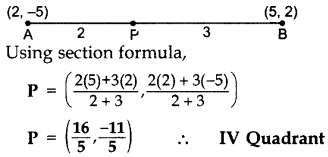
Question 5.
ABCD is a rectangle whose three vertices are B(4, 0), C(4, 3) and D(0, 3). Calculate the length of one of its diagonals. (2014OD)
Solution:
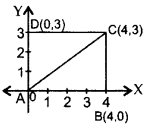
AB = 4 units
BC = 3 units
AC2 = AB2 + BC2 …[Pythagoras’ theorem
= (4)2 + (3)2
= 16 + 9 = 25
∴ AC = 5 cm
Question 6.
In the figure, calculate the area of triagle ABC (in sq. units). (2013D)
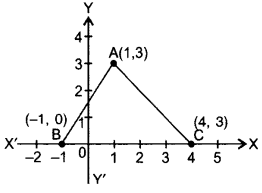
Solution:
Area of ∆ABC = 1/2 × base × corr, altitude
= 1/2 × 5 × 3 = 7.5 sq.units
Coordinate Geometry Class 10 Important Questions Short Answer-I (2 Marks)
Question 7.
Find a relation between x and y such that the point P(x, y) is equidistant from the points A (2, 5) and B (-3, 7). (2011D)
Solution:
Let P (x, y) be equidistant from the points A (2, 5) and B (-3, 7).
∴ AP = BP …[Given
AP2 = BP2 …[Squaring both sides
(x – 2)2 + (y – 5)2 = (x + 3)2 + (y – 7)2
⇒ x2 – 4x + 4 + y2 – 10y + 25
⇒ x2 + 6x + 9 + y2 – 14y + 49
⇒ -4x – 10y – 6x + 14y = 9 +49 – 4 – 25
⇒ -10x + 4y = 29
∴ 10x + 29 = 4y is the required relation.
Question 8.
Find the relation between x and y if the points A(x, y), B(-5, 7) and C(-4, 5) are collinear. (2015OD)
Solution: When points are collinear,
∴ Area of ∆ABC = 0
= (x1 (y2 – y3) + x2(y3 – y1) + x3(y1 – y2)) = 0
= x (7 – 5) – 5 (5 – y) -4 (y – 7) = 0
= 2x – 25 + 5y – 4y + 28 = 0
∴ 2x + y + 3 = 0 is the required relation.
Question 9.
Find the ratio in which the point P(3/4,5/12) divides the line segment joining the points A(1/2,3/2) and B(2, -5). (2015D)
Solution:

Let P divide AB in the ratio of K : 1.
Applying section formula,
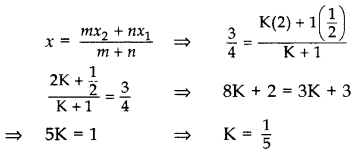
∴ Required ratio = 1 : 5
Question 10.
Find the ratio in which y-axis divides the line segment joining the points A(5, -6), and B(-1, -4). Also find the coordinates of the point of division. (2016D)
Solution:
![]()
Let AC: CB = m : n = k : 1.
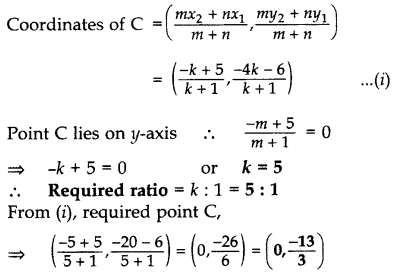
Question 11.
Let P and Q be the points of trisection of the line segment joining the points A (2, -2) and B (-7, 4) such that P is nearer to A. Find the coordinates of P and Question (2016D)
Solution:
![]()
AP : PB = 1 : 2
Coordinates of P are:
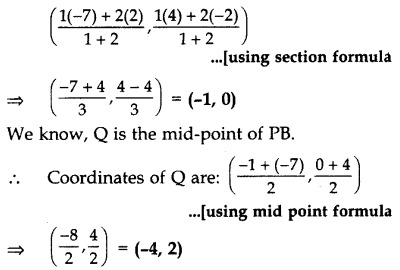
Question 12.
Three vertices of a parallelogram taken in order are (-1, 0), (3, 1) and (2, 2) respectively. Find the coordinates of fourth vertex. (2011D)
Solution:
Let A(-1, 0), B(3, 1), C(2, 2) and D(x, y) be the vertices of a parallelogram ABCD taken in order. Since, the diagonals of a parallelogram bisect each other.
∴ Coordinates of the mid-point of AC = Coordinates of the mid-point of BD
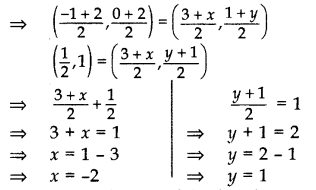
Hence, coordinates of the fourth vertex, D(-2, 1).
Question 13.
A line intersects the y-axis and x-axis at the points P and Q respectively. If (2, -5) is the mid point of PQ, then find the coordinates of P and Question (2017OD)
Solution:
![]()
We know that at y-axis coordinates of points are (0, y) and at x-axis (x, 0).
Let P(0, b) and Q(a,0)
Mid point of PQ = (2, -5) …[Given

Question 14.
Determine the ratio in which the line 3x + y – 9 = 0 divides the segment joining the points (1, 3) and (2, 7). (2011D)
Solution:
Suppose the line 3x + y – 9 = 0 divides the line segment joining A(1, 3) and B(2, 7) in the ratio k : 1 at point C.
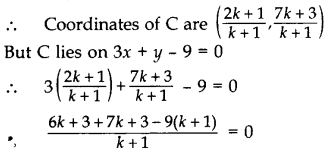
⇒ 6k + 3 + 7k + 3 – 9k – 9 = 0
⇒ 4k – 3 = 0
⇒ 4k = 3 ∴ k = 8
So, the required ratio is 3 : 4 internally.
Question 15.
If A(4, 3), B(-1, y) and C(3, 4) are the vertices of a right triangle ABC, right-angled at A, then find the value of y. (2015OD)
Solution:
We have A(4, 3), B(-1, y) and C(3, 4). In right angled triangle ABC,
(BC)2 = (AB)2 + (AC)…. [Pythagoras theorem
⇒ (-1 – 3)2 + (y – 4)2 = (4 + 1)2 + (3 – y)2 + (4 – 3)2 + (3 – 4)2 …(using distance formula
⇒ (-4)2 + (y2 – 8y + 16)
⇒ (5)2 + (9 – 6y + y2) + (1)2 + (-1)2
⇒ y2 – 8y + 32 = y2 – 6y + 36 = 0
⇒ -8y + 6y + 32 – 36
⇒ -2y – 4 = 0 ⇒ -2y = 4
∴ y = -2
Question 16.
If A(5, 2), B(2, -2) and C(-2, t) are the vertices of a right angled triangle with ∠B = 90°, then find the value of t. (2015D)
Solution:
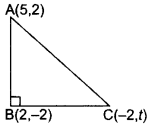
ABC is a right angled triangle,
∴ AC2 = BC2 + AB2 …(i)… (Pythagoras theorem
Using distance formula,
AB2 = (5 – 2)2 + (2 + 2)
= 25
BC2 = (2 + 2)2 + (t + 2)2
= 16 + (t + 2)2
AC2 = (5 + 2)2 + (2 – t)2
= 49 + (2 – t)2
Putting values of AB2, AC2 and BC2 in equation (i), we get
49 + (2 – t)2 = 16 + (t + 2)2 + 25
∴ 49 + (2 – t)2 = 41 + (t + 2)2
⇒ (t + 2)2 – (2 – t)2 = 8
⇒ (t2 + 4 + 4t – 4 – t2 + 4t) = 8
8t = 8 ⇒ t = 1
Question 17.
Find the area of the triangle whose vertices are (1, 2), (3, 7) and (5, 3).(2011OD)
Solution:
Area of Triangle
= 1/2 [x1(y2 – y3) + x2(y3 – y1) + x3 (y1 – y2)]
= 1/2(1(7 – 3) + 3(3 – 2) + 5(2 – 7)]
= 1/2[4 + 3 + 5(-5)] = 18/2 = 9 sq. unit
Question 18.
The points A(4, 7), B(p, 3) and C(7, 3) are the vertices of a right triangle, right-angled at B. Find the value of p. (2015OD)
Solution:
Similar to Question 16, Page 102.
Question 19.
Prove that the points (7, 10), (-2, 5) and (3, -4) are the vertices of an isosceles right triangle. (2013D)
Solution:
Let A (7, 10), B(-2, 5), C(3, -4) be the vertices of a triangle.
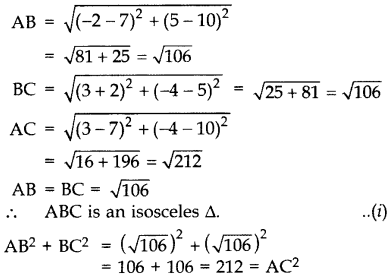
… [By converse of Pythagoras theorem
∆ABC is an isosceles right angled triangle. …(ii) From (i) & (ii), Points A, B, C are the vertices of an isosceles right triangle.
Coordinate Geometry Class 10 Important Questions Short Answer-II (3 Marks)
Question 20.
Find that value(s) of x for which the distance between the points P(x, 4) and Q(9, 10) is 10 units. (2011D)
Solution:
PQ = 10 …Given
PQ2 = 102 = 100 … [Squaring both sides
(9 – x)2 + (10 – 4)2 = 100…(using distance formula
(9 – x)2 + 36 = 100
(9 – x)2 = 100 – 36 = 64
(9 – x) = ± 8 …[Taking square-root on both sides
9 – x = 8 or 9 – x = -8
9 – 8 = x or 9+ 8 = x
x = 1 or x = 17
Question 21.
Find the value of y for which the distance between the points A (3,-1) and B (11, y) is 10 units. (2011OD)
Solution:
AB = 10 units … [Given
AB2 = 102 = 100 … [Squaring both sides
(11 – 3)2 + (y + 1)2 = 100
82 + (y + 1)2 = 100
(y + 1)2 = 100 – 64 = 36
y + 1 = ±6 … [Taking square-root on both sides
y = -1 ± 6 ∴ y = -7 or 5
Question 22.
The point A(3, y) is equidistant from the points P(6, 5) and Q(0, -3). Find the value of y. (2011D)
Solution:
PA = QA …[Given
PA2 = QA2 … [Squaring both sides
(3 – 6)2 + (y – 5)2 = (3 – 0)2 + (y + 3)2
9 + (y – 5)2 = 9 + (y + 3)2
(y – 5)2 = (y + 3)2
y – 5 = ±(y + 3) … [Taking sq. root of both sides
y – 5 = y + 3 y – 5 = -y – 3
0 = 8 … which is not possible ∴ y = 1
Question 23.
If a point A(0, 2) is equidistant from the points B(3, p) and C(p, 5), then find the value of p. (2012D)
Solution:
Similar to Question 24, Page 103.
Question 24.
Find the value of k, if the point P(2, 4) is equidistant from the points A(5, k) and B(k, 7). (2012OD)
Solution:
Let P(2, 4), A(5, k) and B(k, 7).
![]()
PA = PB …[Given
PA2 = PB2 … [Squaring both sides
(5 – 2)2 + (k – 4)2 = (k – 2)2 + (7 – 4)2
9 + (k – 4)2 – (k – 2)2 = 9
(k – 4 + k – 2) (k – 4 – k + 2) = 0
(2k – 6)(-2) = 0
2k – 6 = 0
2k = 6 ∴ k = 6/2 = 3
Question 25.
If the point P(k – 1, 2) is equidistant from the points A(3, k) and B(k, 5), find the values of k. (2014OD)
Solution:
PA = PB …Given
PA2 = PB2 … [Squaring both sides
⇒ (k – 1 – 3)2 + (2 – k)2 = (k – 1 – k)2 + (2 – 5)2
⇒ (k – 4)2 + (2 – k)2 = (-1)2 + (-3)2
k2 – 8k + 16 + 4 + k2 – 4k = 1 + 9
2k2 – 12k + 20 – 10 = 0
2k2 – 12k + 10 = 0
⇒ k2 – 6k + 5 = 0 …[Dividing by
⇒ k2 – 5k – k + 5 = 0
⇒ k(k – 5) – 1(k – 5) = 0
⇒ (k – 5) (k – 1) = 0
⇒ k – 5 = 0 or k – 1 = 0
∴ k = 5 or k = 1
Question 26.
Find a point P on the y-axis which is equidistant from the points A(4, 8) and B(-6, 6). Also find the distance AP. (2014OD)
Solution:
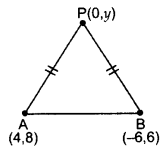
Let P(0, y) be any point on y-axis.
PA = PB … [Given
PA2 = PB2 … [Squaring both sides
⇒ (4 – 0)2 + (8 – y)2 = (-6 – 0)2 + (6 – y)2
16 + 64 – 16y + y2 = 36 + 36 + y2 – 12y
80 – 72 = -12y + 16y
8 = 4y ⇒ y = 2
∴ Point P (0, 2).
Now, AP = √(4−0)2+(8−2)2
∴ Distance, AP = √16+36=√52
Question 27.
If the point P(x, y) is equidistant from the points A(a + b, b – a) and B(a – b, a + b), prove that bx = ay. (2016OD)
Solution:
PA = PB … [Given
PA2 = PB2 … [Squaring both sides
⇒ [(a + b) – x]2 + [(b a) – y)2 = [(a – b) – x]2 + [(a + b) – y]2
⇒ (a + b)2 + x2 – 2(a + b)x + (b – a)2 + y2 – 2(b – a)y = (a – b)2 + x2 – 2(a – b)x + (a + b)2 + y2 – 2(a + b)y …[∵ (a – b) 2 = (b – a)2
⇒ -2(a + b)x + 2(a – b)x = -2(a + b)y + 2(b – a)y
⇒ 2x(-a – b + a – b) = 2y(-a – b + b – a)
⇒ -2bx = – 2ay
⇒ bx = ay (Hence proved)
Question 28.
If the point A(0, 2) is equidistant from the points B(3, p) and C(p, 5), find p. Also find the length of AB. (2014D)
Solution:
AB = AC … [Given
∴ AB2 = AC2 …[Squaring both sides
⇒ (3 – 0)2 + (p – 2)2= (p – 0)2 + (5 – 2)2
⇒ 9+ (p – 2)2 = p2 + 9
⇒ p2 – 4p + 4 – p2 = 0
⇒ -4p + 4 = 0
⇒ -4p = -4 ⇒ p = 1
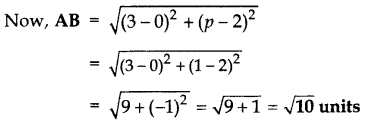
Question 29.
If the point P(2, 2) is equidistant from the points A(-2, k) and B(-2k, -3), find k. Also find the length of AP. (2014D)
Solution:
PA = PB … [Given
PA2 = PB2 … [Squaring both sides
⇒ (2 + 2)2 + (2 – k)2 = (2 + 2k)2 + (2 + 3)2
16 + 4 + k2 – 4k = 4 + 4k2 + 8k + 25
4k2 + 8k + 25 – k2 + 4k – 16 = 0
3k2 + 12k + 9 = 0
⇒ k2 + 4k + 3 = 0 …[Dividing by 3
k2 + 3k + k + 3 = 0
k(k + 3) + 10k + 3) = 0
(k + 1) (k + 3) = 0
k + 1 = 0 ork + 3 = 0
i k = -1 or k = -3
AP = √(2+2)2+(2−k)2
When k = -1
AP =√16+(2+1)2=√16+9 = 5 units
When k = -3
AP = √16+(2+3)2=√16+25 units
Question 30.
Prove that the points (3, 0), (6, 4) and (-1, 3) are the vertices of a right angled isosceles triangle. (2016OD)
Solution:
Similar to Question 19, Page 102.
Question 31.
Prove that the points A(0, -1), B(-2, 3), C(6, 7) and D(8, 3) are the vertices of a rectangle ABCD. (2013D)
Solution:
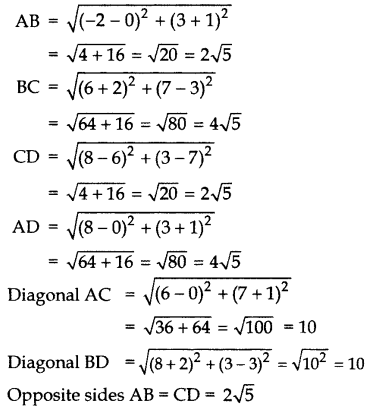
Opposite sides BC = AD = 4√5
Diag. AC = BD = 10
∴ ABCD is a rectangle.
… [∵ Opp. sides are equal & diagonals are also equal
Question 32.
Show that the points (-2, 3), (8, 3) and (6, 7) are the vertices of a right triangle. (2013D)
Solution:
Let A (-2, 3), B(8,3), C(6, 7).
(AB)2 = (8 + 2)2 + (3 – 3)2 = 102 + 02 = 100
(BC)2 = (6 – 8)2 + (7 – 3)2 = (-2)2 + 42 = 20
(AC)2 = (6 + 2)2 + (7 – 3)2 = 82 + 42 = 80
Now, (BC)2 + (AC)2= 20 + 80 = 100 = (AB)2
…[By converse of Pythagoras’ theorem
Therefore, Points A, B, C are the vertices of a right triangle.
Question 33.
Prove that the points A(2, 3), B(-2, 2), C(-1, -2) and D(3, -1) are the vertices of a square ABCD. (2013OD)
Solution:
Given: A(2, 3), B(-2, 2), C(-1, -2), D(3, -1)
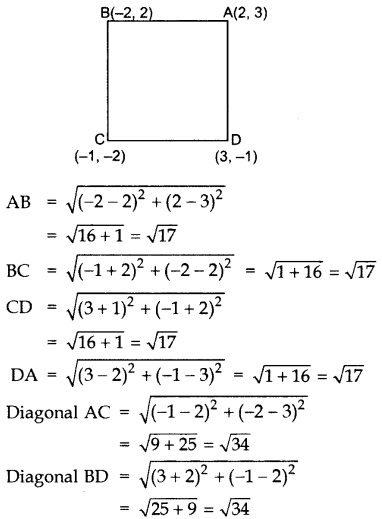
AB = BC = CD = DA …[All four sides are equal
AC = BD …[Also diagonals are equal
∴ ABCD is a Square.
Question 34.
Prove that the points A(2, -1), B(3, 4), C(-2, 3) and D(-3, -2) are the vertices of a rhombus ABCD. Is ABCD a square? (2013OD)
Solution:
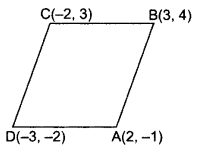
Given: A(2, -1), B(3, 4), C(-2,3), D(-3, -2)
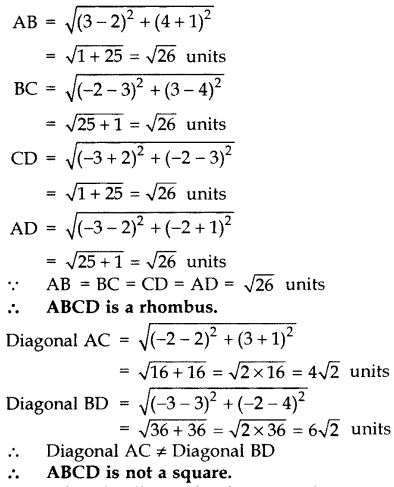
Question 35.
Prove that the diagonals of a rectangle ABCD, with vertices A(2, -1), B(5, -1), C(5, 6) & D(2,6), are equal and bisect each other. (2014OD)
Solution:
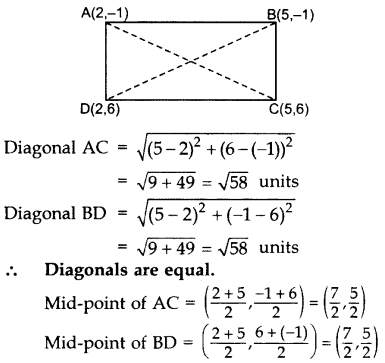
∴ Diagonals also bisect each other.
Question 36.
Find that value of k for which point (0, 2), is equidistant from two points (3, k) and (k, 5). (2013OD)
Solution:
Similar to Question 29, Page 104.
Question 37.
If the points A(-2, 1), B(a, b) and C(4, -1) are collinear and a – b = 1, find the values of a and (2014D)
Solution:
Since A(-2, 1), B(a, b) and C(4, -1) are collinear.
∴ x1(y2 – y3) + x2(y3 – y1) + x3(y1 – y2) = 0
⇒ -2[b – (-1)] + a(-1 – 1) + 4(1 – b) = 0
⇒ -2b – 2 – 2a + 4 – 4b = 0
⇒ -2a – 6b = -2
⇒ a + 3b = 1 … [Dividing by (-2)
⇒ a = 1 – 3
We have, a – b = 1 …[Given
(1 – 3b) – b = 1 …[From (i)
1 – 3b – b = 1
-4b = 1 – 1 = 0 ∴ b = 0/−4 = 0
From (i), a = 1 – 3(0) = 1 – 0 = 1
∴ a = 1, b = 0
Question 38.
If the points A(-1, -4), B(b, c) and C(5, -1) are collinear and 2b + c = 4, find the values of b and c. (2014D)
Solution:
A(-1, -4), B(b, c), C(5, -1) are collinear.
∴ x1(y2 – y3) + x2(y3 – y1) + x3(y1 – y2) = 0
⇒ -1(c + 1) + b(-1 + 4) + 5(-4 – c) = 0
⇒ -c – 1 – b + 4b – 20 – 5c = 0
⇒ 3b – 6c = 21
⇒ – b – 2c = 7 …[Dividing by 3
⇒ b = 7 + 2c
We have, 2b + c = 4 … [Given
2(7 + 2c) + c = 4 … [From (i)
⇒ 14 + 4c + c = 4
⇒ 5c = 4 – 14 = -10 ⇒ c = -2
⇒ b = 7 + 2(-2) = 3 … [From (i)
∴ b = 3, c = -2
Question 39.
Find the area of the triangle ABC with A(1, 4) and mid-points of sides through A being (2, -1) and (0, -1). (2015D)
Solution:
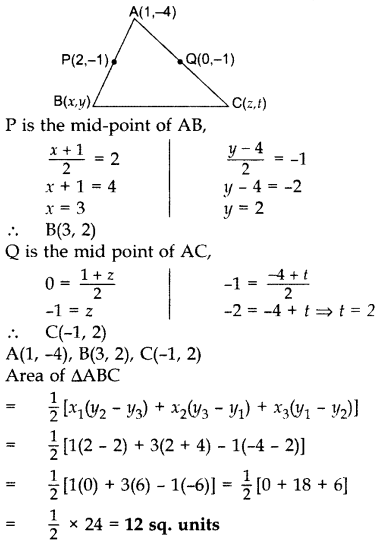
Question 40.
Find the area of the triangle PQR with Q(3, 2) and the mid-points of the sides through Q being (2, -1) and (1, 2). (2015D)
Solution:
Let P(x, y), R(z, t).
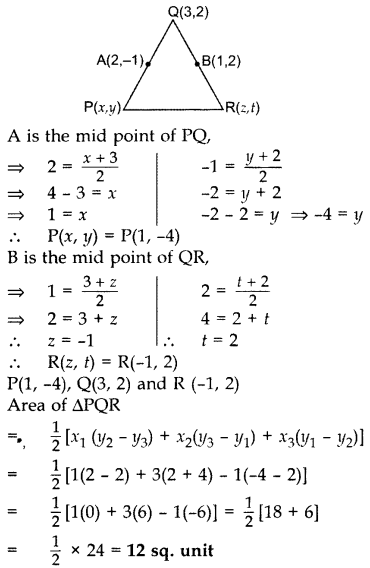
Question 41.
Find the ratio in which the y-axis divides the line segment joining the points (-4, -6) and (10, 12). Also find the coordinates of the point of division. (2013D)
Solution:
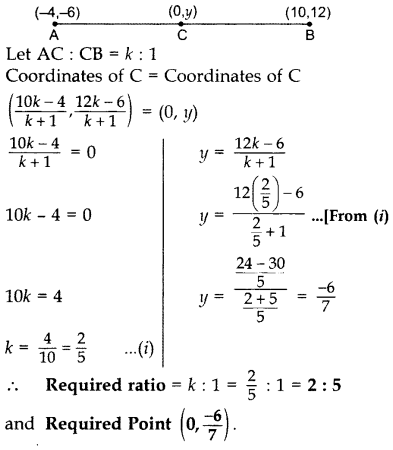
Question 42.
Find the ratio in which point P(-1, y) lying on the line segment joining points A(-3, 10) and B(6, -8) divides it. Also find the value of y. (20130D)
Solution:
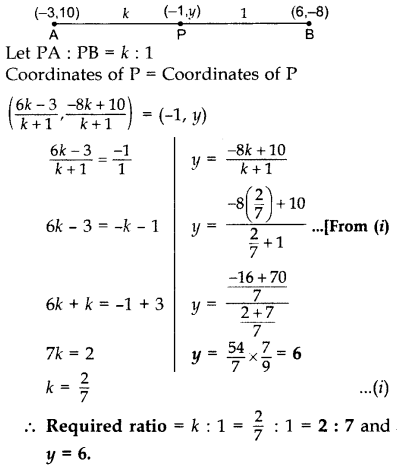
Question 43.
In what ratio does the point (14.4) divide the line segment joining the points P(2, -2) and Q(3, 7)? Also find the value of y. (2017OD)
Solution:
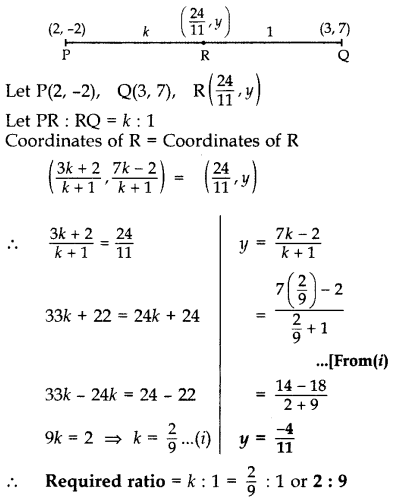
Question 44.
Find the coordinates of a point P on the line segment joining A(1, 2) and B(6, 7) such that AP = AB. (2015OD)
Solution:
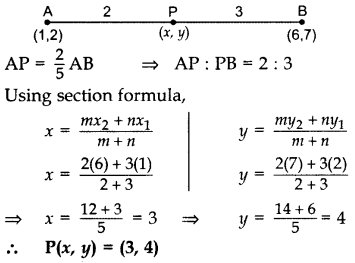
Question 45.
Points A(-1, y) and B(5, 7) lie on a circle with centre 0(2, -3y). Find the values of y. Hence find the radius of the circle. (2014D)
Solution:
Join OA and OB. …[radii of a circle
∴ OA = OB OA2 = OB2 …[Squaring both sides
⇒ (2 + 1)2 + (-3y – y)2 = (5 – 2)2 + (7 + 3y)2
⇒ 9+ (-4y)2 = 9 + (7 + 3y)2
⇒ 16y2 = 49 + 42y + 9y2
⇒ 16y2 – 9y2 – 42y – 49 = 0
⇒ 7y2 – 42y – 49 = 0
⇒ y2 – 6y – 7 = 0 …[Dividing both sides by 7
⇒ y2 – 7y + y – 7 = 0
⇒ y(y – 7) + 1(y – 7) = 0
⇒ (y – 7) (y + 1) = 0
y – 7 = 0 or y + 1 = 0
y = 7 or y = -1
(i) Taking y = 7
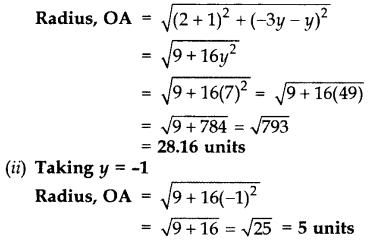
Question 46.
If the points P(-3, 9), Q(a, b) and R(4, -5) are collinear and a + b = 1, find the values of a and b. (2014D)
Solution:
Similar to Question 37, Page 105.
Question 47.
The area of a triangle is 5 sq. units. Two of its vertices are (2, 1) and (3,-2). If the third vertex is (7/2,y), find the value of y. (2017D)
Solution:
Given: Area of ∆ = 5 sq. units
Vertices: (2, 1), (3, -2) and (7/2,y)
Area of ∆
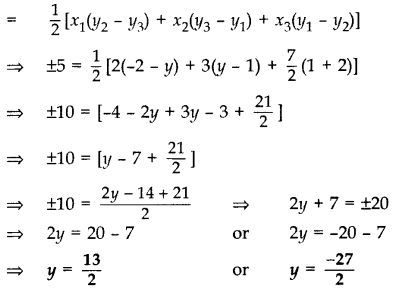
Question 48.
Find the ratio in which the line segment joining the points A(3, -3) and B(-2, 7) is divided by x-axis. Also find the coordinates of the point of division. (2014OD)
Solution:
Similar to Question 41, Page 106.
Question 49.
In the Figure, ABC is a triangle coordinates of whose vertex A are (0, -1). D and E respectively are the mid-points of the sides AB and AC and their coordinates are (1, 0) and (0, 1) respectively. If F is the midpoint of BC, find the areas of ∆ABC and ∆DEF. (2016D)
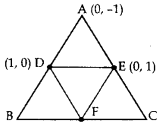
Solution:
Let B (p, q), C (r, s)
and F(x, y)
Mid-point of AB = Coordinates of D
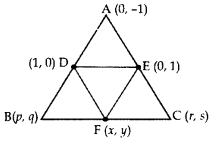
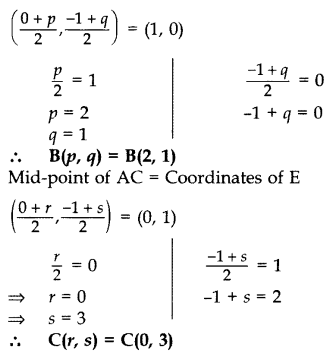
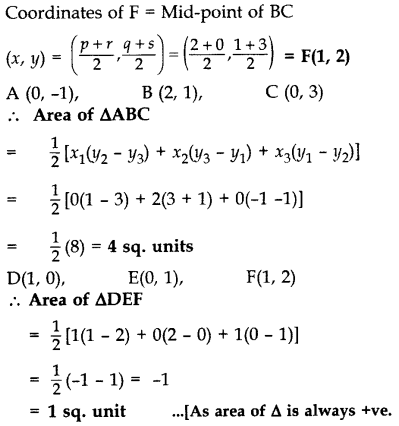
Coordinate Geometry Class 10 Important Questions Long Answer (4 Marks)
Question 50.
If the points A(x, y), B(3, 6) and C(-3, 4) are collinear, show that x – 3y + 15 = 0. (2012OD)
Solution:
Pts. A(x, y), B(3, 6), C(-3, 4) are collinear.
∴ Area of ∆ = 0
As area of ∆
= 1/2[x1(y2 – y3) + x2(y3 – y1) + x3(y1 – y2)]
∴Area of ∆ABC
= x(6 – 4) + 3(4 – y) + (-3) (y – 6) = 0
= 2x + 12 – 3y – 3y + 18 = 0
= 2x – 6y + 30 = 0
∴ x – 3y + 15 = 0 … [Dividing both sides by 2
Question 51.
Find the values of k for which the points A(k + 1, 2k), B(3k, 2k + 3) and C(5k – 1, 5k) are collinear. (2015OD)
Solution:
A (k + 1, 2k), B(3k, 2k + 3) and C(5k – 1, 5k).
When points are collinear, area of ∆ is 0.
∴ Area of triangle = 0
⇒ [x1(y2 – y3) + x2(y3 – y1) + x3(y1 – y2)] = 0
⇒ [(k + 1) (2k + 3 – 5k) + 3k (5k – 2k) + (5k – 1) (2k – 2k – 3)] = 0
⇒ [(k + 1) (3 – 3k) + 3k(3k) + (5k – 1)(-3)] = 0
⇒ [3k – 3k2 + 3 – 3k + 9k2 – 15k + 3) = 0
⇒ 6k2 – 15k + 6 = 0
⇒ 2k2 – 5k + 2 = 0
⇒ 2k2 – 4k – 1k + 2 = 0
⇒ 2k(k – 2) – 1(k – 2) = 0
⇒ (k – 2)(2k – 1) = 0
⇒ k – 2 = 0 or 2k – 1 = 0
⇒ k = 2 or k = 1/2
We get, k = 2, 1/2
Question 52.
If two vertices of an equilateral triangle are (3, 0) and (6, 0), find the third vertex. (2011D)
Solution:
Let A (3,0), B (6, 0), C (x, y).
∴ ∆ABC is an equilateral
∴ AB = BC = AC
AB2 = BC2 = AC2 …[Squaring throughout
(6 – 3)2 + (0 – 0)2 = (x – 6)2 + (1 – 0)2 = (x – 3)2 + (y – 0)2
9 = x2 – 12x + 36 + y2 = x2 – 6x + 9 + y2
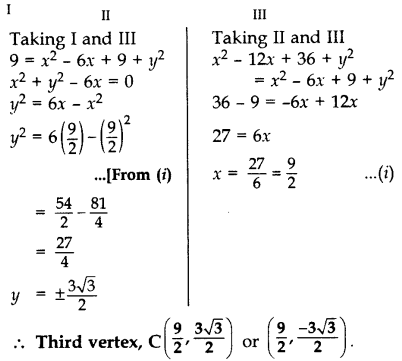
Question 53.
Find the area of the triangle formed by joining the mid-points of the sides of the triangle whose vertices are A(2, 1), B(4, 3) and C(2, 5). (2011D)
Solution:
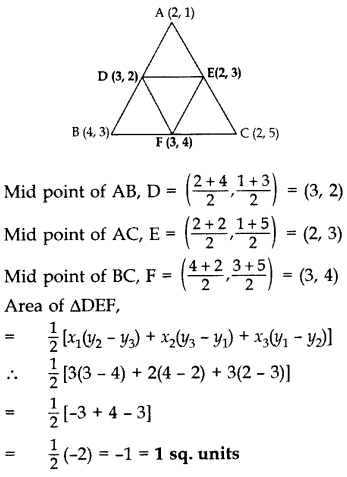
Question 54.
If the vertices of a triangle are (1, -3), (4, p) and (-9, 7) and its area is 15 sq. units, find the value(s) of p. (2012D)
Solution:
Area of ∆ = 15 sq. units
1/2 [1(p – 7) + 4(7 + 3)) + (-9)(-3 – p)] = ±15
p – 7 + 40 + 27 + 9p = ±30
10p + 60 = ± 30
10p = -60 ± 30
p = −60±30/10
∴ Taking +ve sign, p = −60+30/10=−30/10 = -3
Taking -ve sign, p = −60−30/10=−90/10 = -9
Question 55.
For the triangle ABC formed by the points A(4, -6), B(3,-2) and C(5, 2), verify that median divides the triangle into two triangles of equal area. (2013OD)
Solution:
Let A(4, -6), B(3, -2) and C(5, 2) be the vertices of ∆ABC.
Since AD is the median
∴ D is the mid-point of BC.
⇒ D(3+5/2,−2+2/2) ⇒ D(4,0)
Area of ∆ABD
= 1/2 [4(-2 – 0) + 3(0 + 6) + 4(-6 + 2)]
= 1/2 [-8 + 18 – 16) = 1/2 [-6] = -3
But area of A cannot be negative.
∴ ar(∆ABD) = 3 sq.units …(i)
Area of ∆ADC
= 1/2 [4(0 – 2) + 4(2 + 6) + 5(-6 – 0)]
= 1/2(-8 + 32 – 30] = 1/2 [-6] = -3
But area of ∆ cannot be negative.
∴ ar(∆ADC) = 3 sq.units
From (i) and (ii),
∴ Median AD of AABC divides it into two ∆s of equal area.
Question 56.
If A(4, 2), B(7,6) and C(1, 4) are the vertices of a AABC and AD is its median, prove that the median AD divides AABC into two triangles of equal areas. (2014OD)
Solution:
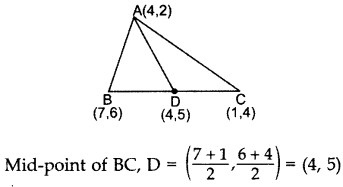
Area of ∆ABD
= 1/2 (x1(y2 – y3) + x2(y3 – y1) + x3(y1 – y2)]
= 1/2[4(6 – 5) + 7(5 – 2) + 4(2 – 6))
= 1/2(4 + 21 – 16) = 92 sq.units …(i)
Area of ∆ADC
= 1/2 [4(5 – 4) + 4(4 – 2) + 162 – 5)]
= 1/2(4 + 8 – 3) = 92sq.units
From (i) and (ii),
Area of ∆ABD = Area of ∆ADC
∴ Median AD divides ∆ABC into two triangles of equal area.
Question 57.
Find the values of k so that the area of the triangle with vertices (k + 1, 1), (4, -3) and (7, -k) is 6 sq. units. (2015OD)
Solution:
Let A(k + 1, 1), B(4, -3) and C(7, -k).
We have, Area of ∆ABC = 6 … [Given
6 = 1/2 [x1(y2 – y3) + x2(y3 – y1) + x3(y1 – y2)]
6 = 1/2[(k + 1)(-3 + k) + 4(-k – 1) + 7(1 + 3)]
12 = (-3k + k2 – 3 + k – 4k – 4 + 28]
12 = [k2 – 6k + 21]
⇒ k2 – 6k + 21 – 12 = 0
⇒ k2 – 6k + 9 = 0
⇒ k2 – 3k – 3k + 9 = 0
⇒ k(k – 3) – 3(k – 3) = 0 =
⇒ (k – 3) (k – 3) = 0
⇒ k – 3 = 0 or k – 3 = 0
⇒ k = 3 or k = 3
Solving to get k = 3.
Question 58.
Prove that the area of a triangle with vertices (t, t – 2), (t + 2, t + 2) and (t + 3, t) is independent of t. (2016D)
Solution:
Let A(t, t – 2), B(t + 2, + + 2), C(t + 3, t).
Area of ∆ABC
= 1/2[x1(y2 – y3) + x2(y3 – y1) + x3(y1 – y2)]
= 1/2 [t(t + 2 – t) + (t + 2)(t – (t – 2)) +(t + 3)((t – 2) – (t + 2))]
= 1/2 [t(2) + (t + 2)(2) + (t + 3)(-4)]
= 1/2 (2+ + 2+ + 4 – 46 – 12] = 1/2 [-8] = -4
Area of ∆ is always positive.
∴ Area of ∆ = 4 sq. units, which is independent of t.
Question 59.
If the centroid of ∆ABC, in which A(a, b), B(b, c), C(c, a) is at the origin, then calculate the value of (a3 + b3 + c). (2012OD)
Solution:
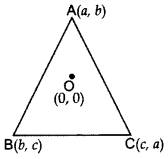
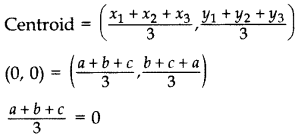
a + b + c = 0
If a + b + c = 0
then, as we know
a3 + b3 + c3 – 3abc = (a + b + c)(a2 + b2 + c2 – ab – bc – ac) ∴ a3 + b3 + c3 – 3abc = 0 … [Since a + b + c = 0
∴ a3 + b3 + c3 = 3abc …(Hence proved)
Question 60.
If the area of triangle ABC formed by A(x, y), B(1, 2) and C(2, 1) is 6 square units, then prove that x + y = 15 or x + y = -9. (2013D)
Solution:
Let A(x, y), B(1, 2), C(2, 1).
Area of ∆ABC = 6 sq. units …[Given
As 1/2 [x1(y2 – y3) + x2(y3 – y1) + x3(y1 – y2)] = 6
∴ x(2 – 1) + 1(1 – y) + 2(y – 2) = ±12
x + 1 – y + 2y – 4 = ±12
Taking +ve sign
x + y = 12 + 4 – 1
∴ x + y = 15
Taking -ve sign
x + y = -12 + 4 – 1
∴ x + y = -9
Question 61.
In the given figure, the vertices of ∆ABC are A(4, 6), B(1, 5) and C(7, 2). A line segment DE is drawn to intersect the sides AB and AC at D and E respectively such that AD/AB=AE/AC=1/3. Calculate the area of ∆ADE and compare it with area of ∆ABC. (2016OD)
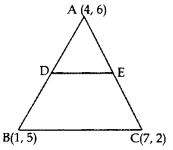
Solution:
AD : AB = 1 : 3; AE : AC = 1 : 3
∴AD : DB = 1 : 2; AE : EC = 1 : 2
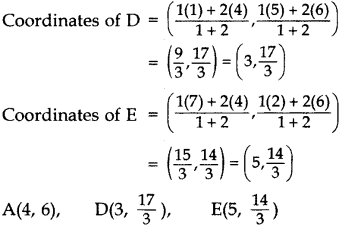
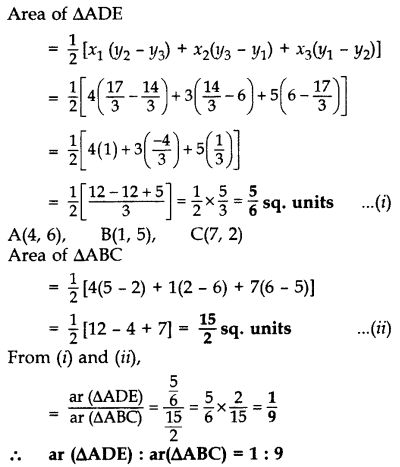
Question 62.
Point P(x, 4) lies on the line segment joining the points A(-5, 8) and B(4, -10). Find the ratio in which point P divides the line segment AB. Also find the value of x. (2011OD)
Solution:
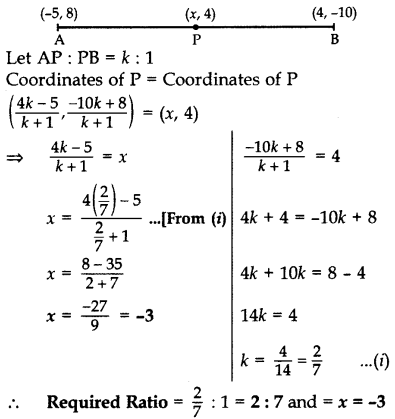
Question 63.
A point P divides the line segment joining the points A(3, -5) and B(-4, 8) such that AP/PB=K/1. If P lies on the line x + y = 0, then find the value of K. (2012D)
Solution:
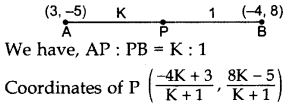
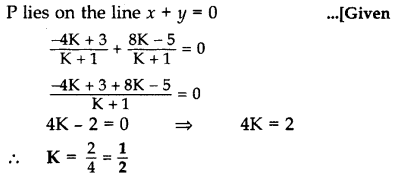
Question 64.
Find the ratio in which the point P(x, 2) divides the line segment joining the points A(12, 5) and B(4, -3). Also, find the value of x. (2014D)
Solution:
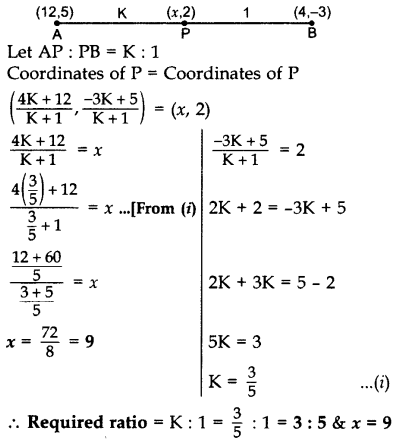
Question 65.
If (3, 3), (6, y), (x, 7) and (5, 6) are the vertices of a parallelogram taken in order, find the values of x and y. (2011D)
Solution:
Let A (3, 3), B (6, y), C (x, 7) and D (5, 6).
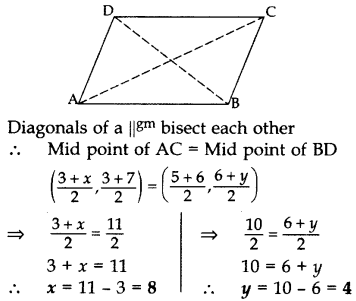
Question 66.
Find the area of the quadrilateral ABCD whose vertices are A(-3, -1), B(-2, -4), C(4, -1) and D(3, 4). (2011D, 2012OD)
Solution:
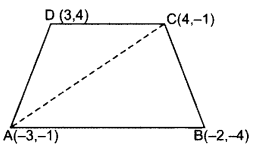
Area of ∆ = 1/2[x1(y2 – y3) + x2(y3 – y1) + x3(y1 – y2)]
∴ Area of ∆ABC
= 1/2[(-3)(4 + 1) + (-2){-1 – (-1)} +4{-1 – (- 4}}]
= 1/2[9+ 0 + 12] = 21 sq. units …(i)
∴ Area of ∆ACD
= 1/2[-3(-1 – 4) + 4{(4 – (-1)} + 34{-1 – (-1)}]
= 1/2 [15 + 20 + 0]
= 1/2[15 + 20] = 35/2 sq. units
∴ ar(quad. ABCD) = ar (∆ABC) + ar(∆ACD)
= 21/2+35/2 …[From (i) & (ii)
= 56/2 = 28 sq. units
Question 67.
The three vertices of a parallelogram ABCD are A(3, 4), B(-1, -3) and C(-6, 2). Find the coordinates of vertex D and find the area of ABCD. (2013D)
Solution:
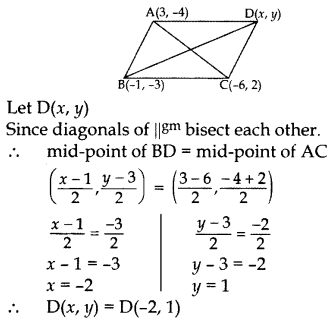
Area of ∆ = 1/2[x1(y2 – y3) + x2(y3 – y1) + x3(y1 – y2)]
∴ Area of ∆ABC
= 1/2 [3(-3 – 2) + (-1)(2 + 4) + (-6)(+4+3)]
= 1/2 [-15 – 6 +6] = −152
= 15/2 sq. units …[∵ ar of A cannot be -ve.
Since diagram of a parallelogram divides it into 2 equal areas.
∴ ar(||gm ABCD) = 2(area of ∆ABC) = 2(15/2)
= 15 sq. units
Question 68.
If the points A(1, -2), B(2, 3), C(-3, 2) and D(-4, -3) are the vertices of parallelogram ABCD, then taking AB as the base, find the height of this parallelogram. (2013OD)
Solution:
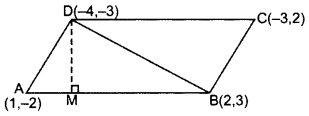
1st method. A(1, -2), B(2, 3), D(-4, -3)
.. Area of ∆ABD
= 1/2 [x1(y2 – y3) + x2(y3 – y1) + x3(y1 – y2)]
= 1/2 [1(3 + 3) + 2(-3 + 2) + (-4)(-2 – 3)]
= 1/2 [6 – 2 + 20) = 24/2 sq.units
ar(∆ABD) = 12 sq.units
= 1/2 × AB × DM = 12 sq.units …[Area of ∆ = 1/2 × Base × Altitude
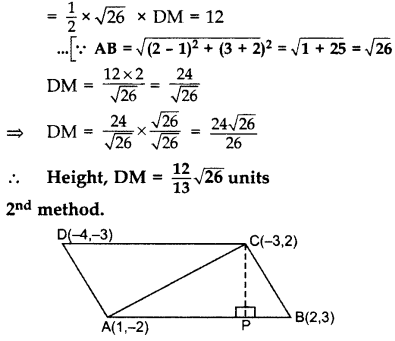
Area of ∆ABC
= 1/2 [x2(y2 – y3) + x2(y3 – y1) + x3(y1 – y2)]
= 1/2[1(3 – 2) + 2(2 + 2) + (-3)(-2 – 3)]
= 1/2[1 + 8 + 15] = 12 sq. unit
Area of ∆ABC = 12
⇒ 1/2 × AB × CP = 12 …[Area of ∆ = 1/2 × Base × Height


Question 69.
Find the value of k, if the points P(5, 4), Q(7, k) and R(9, – 2) are collinear. (2011D)
Solution:
Given points are P(5, 4), Q(7, k) and R(9, -2).
x1 (y2 – y3) + x2(y3 – y1) + x3(y1 – y2) = 0 …[∵ Points are collinear
∴ 5 (k + 2) + 7 (- 2 – 4) + 9 (4 – k) = 0
5k + 10 – 14 – 28 + 36 – 9k = 0
4 = 4k ∴ k=1
Question 70.
If P(2, 4) is equidistant from Q(7, 0) and R(x, 9), find the values of x. Also find the distance PQuestion (2011D)
Solution:
![]()
PQ = PR …[Given
PQ2 = PR2 … [Squaring both sides
∴ (7 – 2)2 + (0 – 4)2 = (x – 2)2 + (9 – 4)2
⇒ 25 + 16 = (x – 2)2 + 25
⇒ 16 = (x – 2)2
⇒ ±4 = x – 2 …[Taking sq. root of both sides
⇒ 2 ± 4 = x
⇒ x = 2 + 4 = 6 or x = 2 – 4 = -2
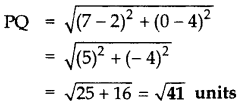
Question 71.
Find the point of y-axis which is equidistant from the points (-5, -2) and (3, 2). (2011D)
Solution:
Similar to Question 26, Page 103.
Question 72.
Point M(11, y) lies on the line segment joining the points P(15, 5) and Q(9, 20). Find the ratio in which point M divides the line segment PQuestion Also find the value of y. (2011OD)
Solution:
Similar to Question 62, Page 110.
Question 73.
Find the coordinates of a point P, which lies on the line segment joining the points A(-2, -2) and B(2, -4) such that AP = 3/7AB. (2012OD)
Solution:
![]()
AP = 3/7AB …(Given)
APAB=3/7
Let AP = 3K, AB = 7K
BP = AB – AP = 7K – 3K = 4K
∴ AP/AB=3K/4K=3/4
Using Section formula, we have
P(6−8/3+4,−12−8/3+4)⇒(−2/7,−20/7)
Question 74.
Find the value of k, for which the points A(6,-1), B(k, -6) and C(0, -7) are collinear. (2012OD)
Solution:
Similar to Question 69, Page 112.
Question 75. Find the value of p, if the points A(1, 2), B(3, p) and C(5, -4) are collinear. (2012OD)
Solution:
Similar to Question 69, Page 112.
Question 76. Find the value of x for which the points (x, -1), (2, 1) and (4, 5) are collinear. (2013D)
Solution:
Similar to Question 69, Page 112.
Question 77.
Find the area of a parallelogram ABCD if three of its vertices are A(2, 4), B(2 + √3, 5) and C(2,6). (2013OD)
Solution:
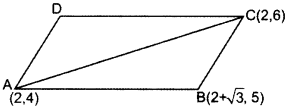
Area of ∆ABD
= 1/2 (x1(y2 – y3) + x2(y3 – y1) + x3(y1 – y2)]
= 1/2 [2(5 – 6) + (2 + √3)(6 – 4) + 2(4 – 5))
= 1/2 (-2 + 4 + 2√3 – 2)
= 1/2 (2√3) = √3
Since diagonal of a ||gm divides it into two equal areas.
Area of ABCD (||gm) = 2(Area of ∆ABC)
= 23–√3 sq. units
Question 78.
If A(-3,5), B(-2, -7), C(1, -8) and D(6, 3) are the vertices of a quadrilateral ABCD, find its area. (2014OD0
Solution:
Similar to Question 66, Page 111.
Question 79.
A(4, -6), B(3, -2) and C(5, 2) are the vertices of a ∆ABC and AD is its median. Prove that the median AD divides AABC into two triangles of equal areas. (2014OD)
Solution:
Similar to Question 56, Page 109.
Question 80.
If A(-, 8), B(-3,-4), C(0, -5) and D(5, 6) are the vertices of a quadrilateral ABCD, find its area. (2015D)
Solution:
Similar to Question 66, Page 111.
Question 81.
If P(-5, -3), Q(-4, -6), R(2, -3) and S(1, 2) are the vertices of a quadrilateral PQRS, find its area. (2015D)
Solution:
Similar to Question 66, Page 111.
Question 82.
Find the values of k so that the area of the triangle with vertices (1, -1), (-4, 2k) and (-k, -5) is 24 sq. units. (2015OD)
Solution:
Similar to Question 57, Page 109.
Question 83.
The x-coordinate of a point P is twice its y coordinate. If P is equidistant from Q (2, -5) and R(-3, 6), find the coordinates of P. (2016D)
Solution:
Let the point P be (2k, k), Q(2,-5), R(-3, 6)
![]()
PQ = PR …Given
PQ2 = PR2 …[Squaring both sides
(2k – 2)2 + (k + 5)2 = (2k + 3)2 + (k – 6)2 …Given
4k2 + 4 – 8k + k2 + 10k + 25 = 4k2 + 9 + 12k + k2 – 12k + 36
⇒ 2k + 29 = 45
⇒ 2k = 45 – 29
⇒ 2k = 16
⇒ k = 8
Hence coordinates of point P are (16, 8).
CBSE Class 10 Maths Notes Chapter 7 Coordinate Geometry
- Position of a point P in the Cartesian plane with respect to co-ordinate axes is represented by the ordered pair (x, y).
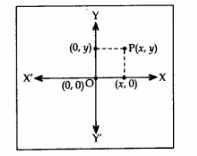
- The line X’OX is called the X-axis and YOY’ is called the Y-axis.
- The part of intersection of the X-axis and Y-axis is called the origin O and the co-ordinates of O are (0, 0).
- The perpendicular distance of a point P from the Y-axis is the ‘x’ co-ordinate and is called the abscissa.
- The perpendicular distance of a point P from the X-axis is the ‘y’ co-ordinate and is called the ordinate.
- Signs of abscissa and ordinate in different quadrants are as given in the diagram:
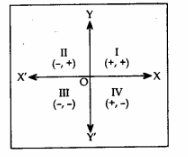
- Any point on the X-axis is of the form (x, 0).
- Any point on the Y-axis is of the form (0, y).
- The distance between two points P(x1, y1) and Q (x2, y2) is given by
PQ = √(x2−x1)2+(y2−y1)2
Note. If O is the origin, the distance of a point P(x, y) from the origin O(0, 0) is given by
OP = √x2+y2
Section formula. The coordinates of the point which divides the line segment joining the points A(x1, y1) and B(x2, y2) internally in the ratio m : n are:

The above formula is section formula. The ratio m: n can also be written as m/n : 1 or k : 1, The
co-ordinates of P can also be written as P(x,y) = kx2+x1/k+1,ky2+y1/k+1
The mid-point of the line segment joining the points P(x1, y1) and Q(x2, y2) is

Here m : n = 1 :1.
Area of a Triangle. The area of a triangle formed by points A(x1 y1), B(x2, y2) and C(x3, y3) is given by | ∆ |,
![]()
where ∆ represents the absolute value.
- Three points are collinear if |A| = 0.
- If P is centroid of a triangle then the median divides it in the ratio 2 :1. Co-ordinates of P are given by
P=(x1+x2+x3/3,y1+y2+y3/3)
Area of a quadrilateral, ABCD = ar(∆ABC) + ar(∆ADC)

